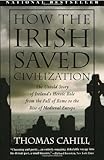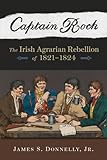|
|
Help |
| Home - Basic I - Ireland History (Books) | |
e99 Online Shopping Mall
|
|
Help |
| Home - Basic I - Ireland History (Books) | |
| Back | 41-60 of 100 | Next 20 |
click price to see details click image to enlarge click link to go to the store
| 41. How the Irish Saved Civilization (Hinges of History) by Thomas Cahill | |
 | Paperback: 256
Pages
(1996-02-01)
list price: US$15.00 -- used & new: US$4.30 (price subject to change: see help) Asin: 0385418493 Average Customer Review: Canada | United Kingdom | Germany | France | Japan |
|
Editorial Review Product Description Customer Reviews (291)
| |
| 42. A hidden phase of American history: Ireland's part in America's struggle f by Michael Joseph O'Brien | |
 | Kindle Edition:
Pages
(2009-08-22)
list price: US$0.99 Asin: B002RHOV3G Canada | United Kingdom | Germany | France | Japan |
| 43. Castles of Ireland; some fortress histories and legends by Constance Louisa Adams | |
 | Paperback: 382
Pages
(2010-08-23)
list price: US$33.75 -- used & new: US$23.03 (price subject to change: see help) Asin: 1177658852 Canada | United Kingdom | Germany | France | Japan |
|
Editorial Review Product Description | |
| 44. Blood on the Shamrock: A Novel of Ireland's Civil War by Cathal Liam | |
 | Paperback: 594
Pages
(2008-09-15)
list price: US$17.00 -- used & new: US$12.00 (price subject to change: see help) Asin: 0970415524 Average Customer Review: Canada | United Kingdom | Germany | France | Japan |
|
Editorial Review Product Description This work of historical fiction continues the chronicle of Aran Roe O'Neill, a fictional Irishman, and his tenacious comrades, both real and imagined. Together they reluctantly renew their struggle for Ireland's long-denied independence from England. Their action is triggered by the divisive treaty Dublin's fledging government negotiates with members of London's parliamentary leadership. Customer Reviews (3)
| |
| 45. Ireland in the Later Middle Ages (Gill History of Ireland, Vol 6) by James Lydon | |
| Paperback: 193
Pages
(1973-06)
list price: US$9.95 -- used & new: US$159.72 (price subject to change: see help) Asin: 0717105636 Canada | United Kingdom | Germany | France | Japan | |
| 46. A New History of Ireland, Volume IV: Eighteenth Century Ireland 1691-1800 | |
 | Paperback: 914
Pages
(2009-11-30)
list price: US$55.00 -- used & new: US$43.02 (price subject to change: see help) Asin: 0199563721 Canada | United Kingdom | Germany | France | Japan |
|
Editorial Review Product Description | |
| 47. The Oxford History of Ireland: Reissue | |
 | Paperback: 368
Pages
(2001-12-27)
list price: US$18.99 -- used & new: US$9.61 (price subject to change: see help) Asin: 019280202X Average Customer Review: Canada | United Kingdom | Germany | France | Japan |
|
Editorial Review Product Description Customer Reviews (6)
| |
| 48. Irish History For Dummies by Mike Cronin | |
 | Paperback: 432
Pages
(2006-01-18)
list price: US$19.99 -- used & new: US$11.58 (price subject to change: see help) Asin: 0764570404 Average Customer Review: Canada | United Kingdom | Germany | France | Japan |
|
Editorial Review Product Description Ireland’s story is an amazingly dramatic and intense one – and today the influence of Irish culture can be felt around the globe. This book helps you find out why, taking you on a rollercoaster journey through the highs and lows of Ireland’s past including invasions, battles, executions, religious divide, uprisings, emigration – and Riverdance! Mike Cronin is a lecturer at the Centre for Irish Programmes, Boston College, Dublin. He has written 5 books on Irish history. Discover: Customer Reviews (6)
| |
| 49. The Oxford Illustrated History of Modern Europe (Oxford Illustrated Histories) | |
 | Paperback: 376
Pages
(2001-09-20)
list price: US$29.95 -- used & new: US$17.50 (price subject to change: see help) Asin: 0192854267 Average Customer Review: Canada | United Kingdom | Germany | France | Japan |
|
Editorial Review Product Description Customer Reviews (1)
Blanning, a professor of history at Cambridge, provided editorial direction for the text, and also contributed one of the chapters of the book.The topics and chapters are overlapping, sometimes focused upon a particular theme (Warfare in Europe since 1918, by Richard Overy, is one such example) or along broad topical lines (Industrialisation of Modern Europe, 1750-1914, by Clive Trebilcock is representative here). The first chapter is devoted to politics from the French Revolution to the First World War.John Roberts examines in this chapter politics internal to various nations as well as the foreign relations among the European states, culminating first in the Congress of Vienna after the Napoleonic era, to its final breakdown in the First World War.The changing face of politics across the European continent in terms of increasingly democratic structures and a lessening of royal and aristocratic government is a common theme.These themes are carried forward in essays on the reordering of European society (Pamela Pilbeam), the upheavals during the interwar period (Paul Preston), changes in recent European society (Richard Bessel) and the final, up-to-date analysis by David Reynolds. Industrialisation and commercialisation are common themes across the history of modern Europe, discussed in different chapters by Clive Trebilcock, T.C.W. Blanning, and Harold James.Their topics are not neatly compartmentalised, and complement each others' texts, as well as the other chapters in the book, quite well.Military themes are also constant across the period, and are addressed in chapters on military modernisation (Hew Strachan), and post-World War I warfare hot and cold (Richard Overy). Martin Jay contributed a chapter entitled `From Modernism to Post-Modernism'.This chapter looks at issues in art, literature, media and philosophy as well as the impact of the general changes in intellectual history have had on general European society and sensibilities.This chapter more than any other examines the role of artistic and aesthetic disciplines on general society. Blanning provides a good list for further reading, divided by the chapter headings, and further subdivided by major topics within the chapters.There is a 12-page chronology, beginning with the Estates-General convention in Versailles during the French Revolutionary period, proceeding through major events up to the 1995 inclusion of Austria, Sweden and Finland into the European Union.There are six maps of Europe in the appendix, which show the progression of national boundaries over time.It is often remarkable to look at the maps of Europe over time to see stability in some areas and massive change in others, particularly in the middle of the continent.The index is useful and comprehensive, keyed to all the different chapters. This is a good reference book, well written and interesting in a narrative format, not too many dates and details for the general reader. ... Read more | |
| 50. To Hell or Barbados: The Ethnic Cleansing of Ireland by Sean O'Callaghan | |
 | Paperback: 248
Pages
(2001-12-31)
list price: US$20.95 -- used & new: US$9.07 (price subject to change: see help) Asin: 0863222870 Average Customer Review: Canada | United Kingdom | Germany | France | Japan |
|
Editorial Review Product Description Customer Reviews (9)
| |
| 51. Dancing with Demons: A Mystery of Ancient Ireland (Mysteries of Ancient Ireland Featuring Sister Fidelma of Cashel) by Peter Tremayne | |
 | Hardcover: 288
Pages
(2008-10-28)
list price: US$24.95 -- used & new: US$8.77 (price subject to change: see help) Asin: B003STCMYW Average Customer Review: Canada | United Kingdom | Germany | France | Japan |
|
Editorial Review Product Description Customer Reviews (7)
| |
| 52. A History of Ireland in the Eighteenth Century (Volume 1) by William Edward Hartpole Lecky | |
 | Paperback: 278
Pages
(2010-01-09)
list price: US$35.72 -- used & new: US$35.72 (price subject to change: see help) Asin: 1152834533 Canada | United Kingdom | Germany | France | Japan |
|
Editorial Review Product Description | |
| 53. War in European History by Michael Howard | |
 | Paperback: 192
Pages
(2009-04-15)
list price: US$19.95 -- used & new: US$9.24 (price subject to change: see help) Asin: 0199546193 Average Customer Review: Canada | United Kingdom | Germany | France | Japan |
|
Editorial Review Product Description Customer Reviews (12)
| |
| 54. Gaelic and Gaelicised Ireland in the Middle Ages (The Gill history of Ireland) by K. W Nicholls | |
| Paperback: 197
Pages
(1972)
Isbn: 071710561X Canada | United Kingdom | Germany | France | Japan | |
| 55. Tudor and Stuart Ireland (The Gill history of Ireland) by Margaret MacCurtain | |
| Unknown Binding: 211
Pages
(1979)
Asin: B0007B5YXA Canada | United Kingdom | Germany | France | Japan | |
| 56. Ireland before the Vikings (The Gill history of Ireland) by Gearoid Mac Niocaill | |
| Paperback: 172
Pages
(1972)
-- used & new: US$31.30 (price subject to change: see help) Asin: 071710558X Average Customer Review: Canada | United Kingdom | Germany | France | Japan | |
Customer Reviews (1)
| |
| 57. Ireland in the Eighteenth Century [Gill History of Ireland 8] by E. M Johnston-Liik | |
| Paperback: 212
Pages
(1974)
-- used & new: US$26.58 (price subject to change: see help) Asin: 0717105652 Canada | United Kingdom | Germany | France | Japan | |
| 58. The Great Irish Famine (New Studies in Economic and Social History) by Cormac Ó'Gráda | |
 | Paperback: 108
Pages
(1995-10-27)
list price: US$22.99 -- used & new: US$5.00 (price subject to change: see help) Asin: 0521557879 Canada | United Kingdom | Germany | France | Japan |
|
Editorial Review Product Description | |
| 59. Captain Rock: The Irish Agrarian Rebellion of 1821-1824 (History of Ireland & the Irish Diaspora) by James S. DonnellyJr | |
 | Paperback: 512
Pages
(2009-11-12)
list price: US$35.00 -- used & new: US$21.28 (price subject to change: see help) Asin: 0299233146 Canada | United Kingdom | Germany | France | Japan |
|
Editorial Review Product Description | |
| 60. The Modernisation of Irish Society, 1848-1918 (Gill History of Ireland,) by Joseph Lee | |
| Paperback: 180
Pages
(1973)
-- used & new: US$69.86 (price subject to change: see help) Asin: 0717105679 Canada | United Kingdom | Germany | France | Japan | |
| Back | 41-60 of 100 | Next 20 |